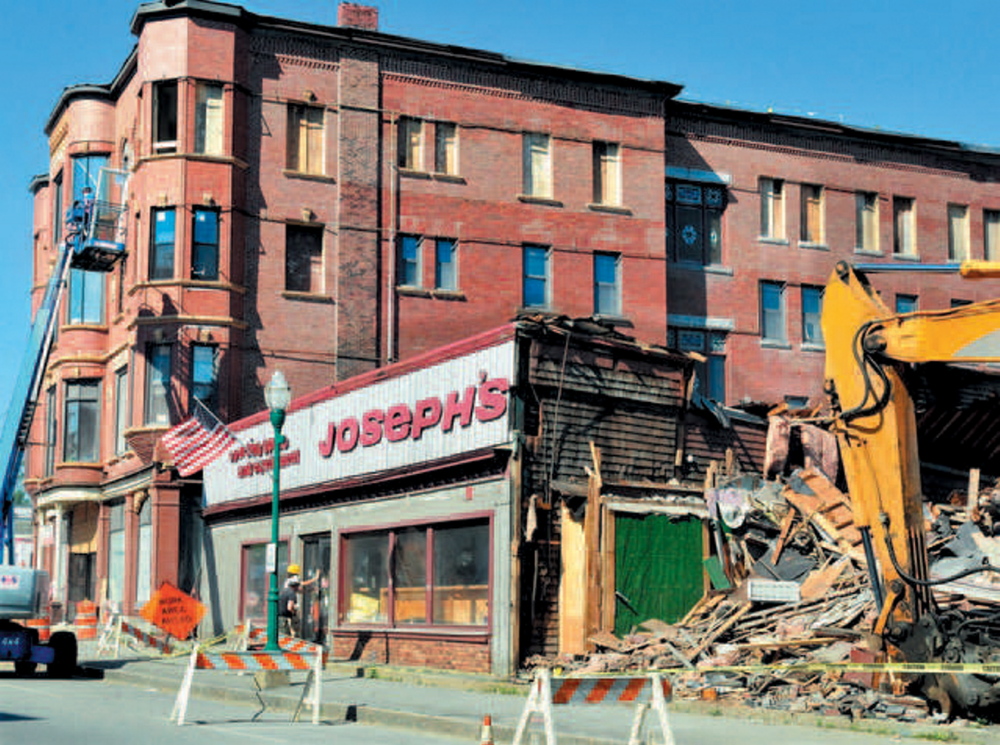In downtown Fairfield, buildings are coming down and hopes are rising that the area can finally become the idyllic Main Street that town leaders have been struggling to create for decades.
“When I drive through town in 10 years, I’d like to see a more welcoming and pretty place,” Town Manager Josh Reny said.
As part of a larger campaign to beautify the area for residents and potential businesses, the town has been tearing out dilapidated buildings.
This week, the Town Council awarded a contract for demolition of two more structures, a single-family home and an apartment building, to clear the way for municipal parking and a footbridge to an island-based park.
The town bought the buildings, 218 and 220 Main St., for about $157,000. They will be torn down by Central Maine Disposal at a cost of $21,980. On the same property, a third town-acquired building, formerly the Busy Bee, may also be demolished, but the town is first exploring whether it might serve a purpose as storage, a public bathroom or an indoor home for the local farmers market, which is expected to relocate to the site.
The buildings are scheduled to come down later this summer, Reny said, as an energized group of town leaders chips away at project after project in an effort that will take a few years
At first, the area cleared by demolition will serve as a grassy park, but over time, public parking spaces and a footbridge from the end of Western Avenue to Mill Island Park will be installed.
The town is getting advice, both free and paid, on how to revitalize the downtown. State grants will pay part of the cost, but the bulk of the funding will come from a tax increment financing district, which captures tax dollars that must then be spent on improvements located within the district.
The TIF district generated about $115,000 last year and has a current balance of just over $17,000.
MEMORIES OF GRANDEUR
Before the district was created by the town’s economic development committee five years ago, town leaders struggled to gain traction in their efforts to restore downtown.
“A lot of people want us to recreate an early 20th century feel with a lot of density, but that’s not realistic,” Reny said.
Fairfield is one of a thousand small American towns that still has faint memories of a heyday during the Roaring â20s.
In those days, about 90 years ago, Fairfield’s downtown was a bustling hub of commerce and entertainment, with the Gerald Hotel a centerpiece for a retail strip that included a busy range of grocery stores, barbershops, clothing stores, restaurants and dance halls.
The memories are wonderful, but those years are not coming back, Reny said.
Since the 1980s, there have been efforts to recapture that former glory, but little progress. As recently as two years ago, vacant storefronts on upper Main Street outnumbered the occupied ones.
IMAGINING A FUTURE
Given Fairfield’s assets — two exits off Interstate 95, Kennebec Valley Community College, a scenic stretch of the Kennebec River and an easily identifiable downtown — the lack of success was particularly discouraging.
Reny said the town has tried to imagine a future that honors the past by preserving certain buildings, but that also takes advantage of future trends by destroying blighted buildings and creating new attractive public spaces.
“It’s just making a more welcoming and pedestrian friendly area,” he said, “that you would want to walk down and stop and get a slice of pizza at Sonny’s and then play at the park with the kids for awhile, then pop into a store and do some shopping.”
What some see as a turning point came with the TIF district, which provided money to fund the bold plans that had previously garnered little more than talk.
The town has leveraged TIF money to win state and federal grants.
“It seems that each year we’re chipping away bit by bit, making some big improvements and some small improvements,” Rey said.
Last year, the town oversaw the demolition of Joseph’s Sporting Goods building and an old bottle redemption center. Those two buildings flanked the historic Gerald Hotel, the subject of a $6.5 million project that converted the building into senior apartments last year.
“It’s not going to look like it did 100 years ago,” Reny said, “but 10 years from now, we’re going to have a thriving downtown area.”
Matt Hongoltz-Hetling — 861-9287 | mhhetling@centralmaine.com | Twitter: @hh_matt
Send questions/comments to the editors.



Success. Please wait for the page to reload. If the page does not reload within 5 seconds, please refresh the page.
Enter your email and password to access comments.
Hi, to comment on stories you must . This profile is in addition to your subscription and website login.
Already have a commenting profile? .
Invalid username/password.
Please check your email to confirm and complete your registration.
Only subscribers are eligible to post comments. Please subscribe or login first for digital access. Here’s why.
Use the form below to reset your password. When you've submitted your account email, we will send an email with a reset code.